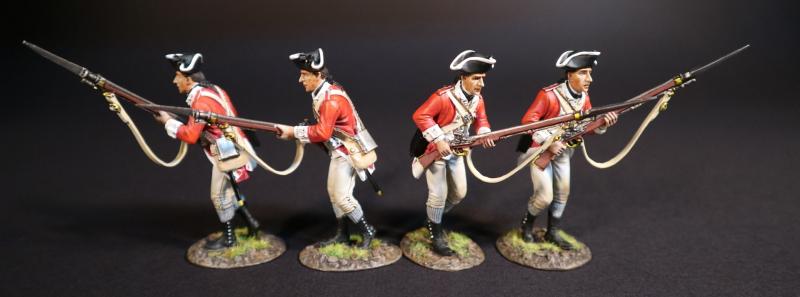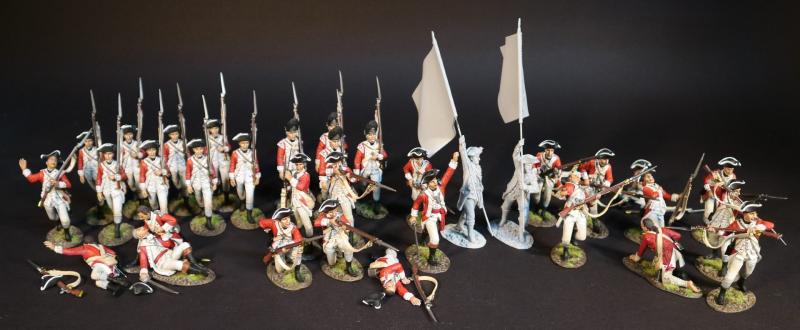Four British Marines, The Assault on the Redoubt at Breeds Hill, The Battle of Bunker Hill, June 17th 1775, The American War of Independence, 1775–1783--four figures advancing with bayonets
$162.00
Item Number: MBHL-11N
Four British Marines, The Assault on the Redoubt at Breeds Hill, The Battle of Bunker Hill, June 17th 1775, The American War of Independence, 1775–1783--four figures advancing with bayonets
Boston was the third largest town in North America, and stood on a Peninsula connected to the mainland by a neck just wide enough to cross at high tide. The harbour, large enough to be strategically significant, and central to the town’s economy, was formed by a chain of islands stretching out to sea, guarded by reefs and ledges. North west of Boston was Charlestown, a largely rural peninsula one and a half miles long. Charlestown stood at the south east corner with three hills behind it. Bunker’s Hill, nearest the neck of the Peninsula, Breed’s Hill 200 yards above the town and Moulton’s Hill to the north east.
On the 16th June 1775, 3 detachments from Massachusetts regiments under the command of Colonel William Prescott and engineer Captain Richard Gridley, crossed the Charlestown neck and arrived at Bunker Hill. Captain Richard Gridley and Prescott disagreed as to where they should locate their defense. Some work was performed on Bunker Hill, but Breed’s Hill was closer to Boston and viewed as being more defensible, and they decided to build their primary redoubt there. Prescott and his men began digging a square fortification about 130 ft a side with ditches and earthen walls. The walls of the redoubt were about 6 feet high.
Work began at midnight, and around 4am one of the British warships spotted the earthworks on Breed’s Hill and opened fire. The British command agreed that the works posed a significant threat, but were at this time sufficiently incomplete and isolated to offer a chance of a successful attack.
The original British plan was to bypass the redoubt to the north and capture Bunker’s Hill and the neck of the peninsula, thus isolating the redoubt on Breed’s Hill.
The Americans repulsed two British assaults, with significant British casualties. The British captured the redoubt on their third assault, after the defenders had run out of ammunition. The colonists retreated over Bunker Hill, leaving the British finally in control of the Peninsula.
The battle was a tactical victory for the British, but it proved to be a sobering experience for them; they incurred many more casualties than the Americans had sustained, including many officers. The battle had demonstrated that inexperienced militia were able to stand up to regular army troops in battle. Subsequently, the battle discouraged the British from any further frontal attacks against well defended front lines. American casualties were much fewer, although their losses included General Joseph Warren, and Major Andrew McClary, the final casualty of the battle.
BRITISH MARINES
The Marines, which only became “Royal Marines” in 1802, were the Royal Navy’s private army, administered by the Admiralty and controlled by senior naval officers. The rank and file were volunteers and wore army style uniforms and equipment. However they were trained to serve on warships and undertake amphibious operations. The 50 companies, shared between Chatham, Portsmouth and Plymouth, were not regimented, and detachments, or in some cases individual replacements were assigned on an ad hoc basis. The first Marines sent to Boston were to form a battalion of 600 men under Major Pitcairn, but by March only 336 were present, as they soon became an object of inter service rivalry over pay, food and conditions. Although initially physically inferior to their army comrades, and short of essential equipment for service on land, incessant drilling and regular marches into the countryside soon created a fine unit.
Another group of over 700 men arrived in May, and the whole force formed two battalions, with grenadier and light companies.
The 1st and 2nd Marines were to play an important part in the assault on the southern defences of the Breed’s Hill redoubt.
This third attack was made at the point of the bayonet and successfully carried the redoubt. However the final volleys of fire from the colonists cost the life of Major Pitcairn. The defenders had run out of ammunition, reducing the battle to close combat. The advantage turned to the British as their troops were equipped with bayonets on their muskets, while most of the colonists were not.
Colonel Prescott, one of the last men to leave the redoubt, parried bayonet thrusts with his normally ceremonial saber.
Released in OCTOBER 2024.

